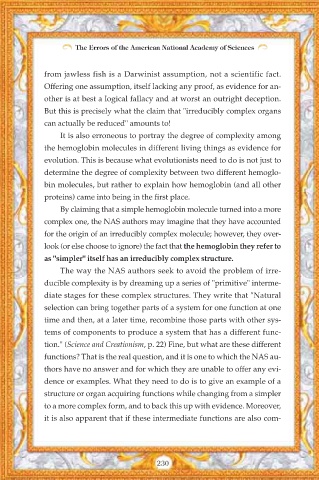Page 232 - The Errors the American National Academy of Sciences
P. 232
The Errors of the American National Academy of Sciences
from jawless fish is a Darwinist assumption, not a scientific fact.
Offering one assumption, itself lacking any proof, as evidence for an-
other is at best a logical fallacy and at worst an outright deception.
But this is precisely what the claim that "irreducibly complex organs
can actually be reduced" amounts to!
It is also erroneous to portray the degree of complexity among
the hemoglobin molecules in different living things as evidence for
evolution. This is because what evolutionists need to do is not just to
determine the degree of complexity between two different hemoglo-
bin molecules, but rather to explain how hemoglobin (and all other
proteins) came into being in the first place.
By claiming that a simple hemoglobin molecule turned into a more
complex one, the NAS authors may imagine that they have accounted
for the origin of an irreducibly complex molecule; however, they over-
look (or else choose to ignore) the fact that the hemoglobin they refer to
as "simpler" itself has an irreducibly complex structure.
The way the NAS authors seek to avoid the problem of irre-
ducible complexity is by dreaming up a series of "primitive" interme-
diate stages for these complex structures. They write that "Natural
selection can bring together parts of a system for one function at one
time and then, at a later time, recombine those parts with other sys-
tems of components to produce a system that has a different func-
tion." (Science and Creationism, p. 22) Fine, but what are these different
functions? That is the real question, and it is one to which the NAS au-
thors have no answer and for which they are unable to offer any evi-
dence or examples. What they need to do is to give an example of a
structure or organ acquiring functions while changing from a simpler
to a more complex form, and to back this up with evidence. Moreover,
it is also apparent that if these intermediate functions are also com-
230

